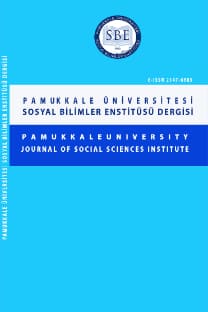TÜRKİYE’DE PROTEİN İÇERİKLİ ÜRÜNLERE YÖNELİK TALEP TAHMİNİ: WORKINGLESER MODELİ
DEMAND ESTIMATION FOR PRODUCTS CONTAINING PROTEIN IN TURKEY: THE WORKINGLESER MODEL
___
- Akbay, C., Bilgiç, A., & Miran, B. (2008). Türkiye’de Önemli Gıda Ürünlerinin Talep Esneklikleri. Turkish Journal of Agricultural Economics, 14(2): 55-65.
- Andreyeva, T., Long, M. W., & Brownell, K. D. (2010). The impact of food prices on consumption: a systematic review of research on the price elasticity of demand for food. American journal of public health, 100(2): 216-222.
- Armagan, G., & Akbay, C. (2008). An econometric analysis of urban households’ animal products consumption in Turkey. Applied Economics, 40(15), 2029-2036.
- Beyaz, B., Koç, A. (2010). Tüketim Kalıpları Üzerinde Gelir ve Sosyodemografik Değişkenlerin Etkisi: Türkiye’de 2003 Hanehalkı Bütçe Anketi Analizi, Akdeniz İİBF Dergisi, 10(20), 41-65.
- Bilgic, A., & Yen, S. T. (2014). Demand for meat and dairy products by Turkish households: A Bayesian censored system approach. Agricultural Economics, 45(2), 117-127.
- Bouamra-Mechemache, Z., Réquillart, V., Soregaroli, C., & Trévisiol, A. (2008). Demand for dairy products in the EU. Food policy, 33(6), 644- 656.
- Coşkun, Ö., & Çevik, S. (2020) Türkiye’de Hanehalklarinin Et Tüketim Kaliplari: Gelirin ve Demografik Faktörlerin Etkisi. Yüzüncü Yıl Üniversitesi Sosyal Bilimler Enstitüsü Dergisi, 0(49), 369-402.
- Demir, Y. (2011). Aydın’da hane halklarının gıda tüketim talebi ekonometrik analizi (Yüksek Lisans Tezi). Adnan Menderes Üniversitesi, Fen Bilimleri Enstitüsü.
- Fulponi, L. (1989). The almost ideal demand system: An application to food and meat groups for France. Journal of Agricultural Economics, 40(1), 82-92.
- He, Y., Yang, X., Xia, J., Zhao, L., & Yang, Y. (2016). Consumption of meat and dairy products in China: a review. Proceedings of the Nutrition Society, 75(3), 385-391.
- Osei-Asare, Y. B., & Eghan, M. (2014). Meat consumption in Ghana, evidence from household micro-data. The Empirical Economics Letters, 13(2), 141-153.
- Sans, P., & Combris, P. (2015). World meat consumption patterns: An overview of the last fifty years (1961– 2011). Meat science, 109, 106-111.
- Selim, S., & Demirkıran, E. (2020). Türkiye’de Hanehalkı Gıda Harcamalarını Etkileyen Sosyo-Ekonomik Faktörler:
- Karşılaştırmalı Bir Analiz. Hacettepe Üniversitesi İktisadi ve İdari Bilimler Fakültesi Dergisi, 38(2), 297-321.
- Şengül, S. (2004). Türkiye’de Gelir Gruplarına Göre Gıda Talebi, ODTÜ Gelişme Dergisi, 115-148. http://www.feas. metu.edu.tr.
- Şengül, S., & Şigez E, Ç. (2013). Türkiye’de Hane Halkı Tüketim Harcamaları: Pseudo Panel Veri ile Talep Sisteminin Tahmini. In International Conference On Eurasian Economies (pp. 279-288).
- Urak, F., Dağdemir, V., & Bilgiç, A. (2017). Türkiye’de Bazı Hayvansal Ürünlere Yapılan Harcamaları Etkileyen Faktörlerin Ekonometrik Analizi. Turkish Journal of Agricultural Economics, 23(1): 43-53.
- Terin, M., Bilgiç, A., Güler, İ., & Yavuz, F. (2015). Türkiye’de Süt Ürünleri Tüketim Harcamalarına Etki Eden Faktörlerin Analizi: Çoklu Heckman Örneklem Seçicilik Sistem Yaklaşımı. Journal of Agricultural Sciences, 21(4): 500-515.
- Yaylak, E., Taşkın, T., Koyubenbe, N., & Konca, Y. (2010). İzmir ili Ödemiş ilçesinde kırmızı et tüketim davranışlarının belirlenmesi üzerine bir araştırma. Hayvansal Üretim, 51(1).
- Working, H. (1943). Statistical Laws of Family Expenditure.Journal of the American Statistical Association, 38(221), 43-56.
- ISSN: 1308-2922
- Yayın Aralığı: 6
- Başlangıç: 2008
- Yayıncı: Pamukkale Üniversitesi
DİL SİYASETİNİN ÜÇ YÖNÜ ÜZERİNE ELEŞTİREL ANALİZ
PERFORMANS DEĞERLENDİRME HATALARINA İLİŞKİN ALGININ ÇALIŞAN SESSİZLİĞİ ÜZERİNDEKİ ETKİSİ
TÜRKİYE SİYASETİNDE BİR SİYASAL BEKA ARACI OLARAK 28 ŞUBAT
İŞ BİLİŞ ENVANTERİ ÖLÇEĞİ: BİR ÖLÇEK UYARLAMASI ÇALIŞMASI
Büşra MÜCELDİLİ, Berivan TATAR, Oya ERDİL
KONUT FİYAT BALONLARI VE BALON OLUŞUMUNU ETKİLEYEN FAKTÖRLER: TÜRKİYE ÖRNEĞİ
Ceren GEDİK, Çisel EKİZ GÖKMEN
Burze YAŞAR, Sinem GÜRAVŞAR GÖKÇE
AVRUPA BİRLİĞİ'NİN COVID-19 YARDIM PAKETİNDE YER ALAN PLASTİK VERGİSİNİN EKONOMİ-POLİTİĞ
